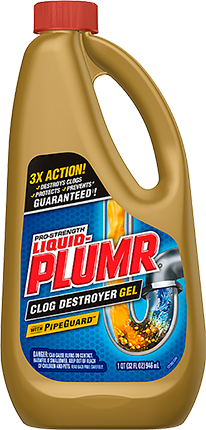NO ONE WANTS A CLEAN-ISH WASHER
How to Clean a Dishwasher & Remove Smelly Odors
How Does a Dishwasher Work?
How you clean dishwashers and the way dishwashers work can vary based on the make and model of the appliance. However, most dishwashers work similarly. Dishwashers have a wash cycle that starts by the dishwasher filling with water. The water is then heated, and the detergent, whether powder, liquid or pod, gets dispensed.
Then, water shoots through jets and mixes with the detergent to clean the dishes. The dirty water drains, the dishes get rinsed with clean water and the rinse water drains. During the final stage, warm air circulates inside the dishwasher to dry the clean dishes. Because dishwashers are made to clean dishes, many people forget to take time to clean the dishwasher or don’t know how to clean the dishwasher and why it’s necessary.
If your dishwasher stinks, keep reading to learn how to clean a dishwasher and our dishwasher cleaning tips to prevent drain clogs.

How Do You Clean the Inside of a Dishwasher?
Before starting to clean your dishwasher with products, and to learn the best way to clean your dishwasher, consult your user’s guide for manufacturer-recommended dishwasher cleaning tips.
Next, remove any food or other debris caught in the dishwasher filter and drain to prevent clogging and improve drainage. You’ll want to regularly clean your dishwasher and remove any food debris to prevent drain clogs. Then, you can begin cleaning with your chosen products according to package instructions.
Liquid Plumr does not work in dishwashers and we have no dishwasher drain cleaners. However, we have other drain cleaning products below that can help unclog your dishwasher by unclogging kitchen and sink drains. We recommend cleaning your dishwasher regularly to prevent a clogged dishwasher.
How Do You Clean a Dishwasher Filter?
Consult your manufacturer’s guide to find out how to clean and remove your dishwasher’s filter. That way you can be sure you’re doing cleaning your dishwasher properly.
To clean a dishwasher, remove the filter and rinse it under clean running water to remove the debris. Once the filter is clean, follow the manufacturer’s instructions on how to replace it.
Why Is the Dishwasher Not Cleaning My Dishes?
If your dishwasher is not cleaning your dishes properly, or if you need to know how to get rid of a dishwasher clog, first check your manufacturer’s guide to ensure you’re loading it correctly and using the right detergent, water temperature and settings.
Also, carefully scrape and rinse all dishes before they go into the dishwasher in order to remove as many food particles as possible to prevent dishwasher clogs.
If your dishwasher still isn’t cleaning your dishes after trying these tips, consult your user’s guide for information to help you troubleshoot. If you have a serious or persistent issue, or a clogged dishwasher, you may need to contact a professional plumber.

Why Is the Dishwasher Not Draining?
If your dishwasher isn’t draining, there could be a clog in the kitchen drain due to food or grease buildup. Check your kitchen drain for a blockage, then use Liquid-Plumr® Clog Destroyer Plus+ Pipeguard™ to clear the clog. Before trying to fix your clogged dishwasher, consider how the kitchen sink is draining and consider using a drain cleaner to unclog the drain.
If your dishwasher isn’t draining because of an issue unrelated to your kitchen sink drain, consult your user’s manual for tips. Learn more about how to unclog a sink drain with our draining cleaning tips.
But, if you have serious or persistent issues, and if you don’t know how to clean your dishwasher on your own, it’s best to seek the help of a professional plumber. For more information, check out this article about when to leave plumbing problems to the pros.
How Do You Clean a Smelly Dishwasher?
If you have a smelly dishwasher, you may not be rinsing your dishes properly before loading them. Food particles can collect in your dishwasher’s filter and crevices. Over time, this can lead to unpleasant odor and can clog dishwashers.
Cleaning your dishwasher regularly can prevent debris from collecting and clogging dishwashers. To keep your dishwasher clean, it’s best to thoroughly scrape and rinse plates, silverware, bowls, and other items before they go into the dishwasher.
Depending on the mess, you probably won’t need to scrub the plates with soap, but scrape food off and rinse dishes clean before loading your dishwasher. Failure to do this means large food particles can get caught in the grates (your dishwasher’s drainage system). This can result in dishwasher clogs that prevent draining or result in a smelly dishwasher.
If there’s food caught in the drain system of your dishwasher, remove it. Then, use a clean sponge to wipe the area clean.
How Do You Maintain a Dishwasher?
We all expect our appliances, and dishwashers, to work properly, so it’s important to maintain them — according to the manufacturer’s instructions.
Each dishwasher has different maintenance needs, so be sure you’re caring for yours properly. However, we can offer some general tips like scraping and rinsing dishes before loading the dishwasher and removing any food caught in the drain system.
Check out our tips on how to maintain the drains in your home.
How Often Should You Clean Your Dishwasher?
To help keep your machine in great shape, it’s best to clean the dishwasher once a month. Food particles, cooking oils and soap scum can sometimes build up over time, which can create a smelly odor or even be a breeding ground for germs. But cleaning it every 30 days with the steps above should do the trick.
For information on how you can use Liquid-Plumr® products, visit our FAQs page.
Cleaning a Dishwasher: Do’s and Don’ts
- DO: pre-rinse your dishes.
- DO: wash dishes with warm or hot water.
- DO: inspect your dishwasher and drain occasionally for buildup of food particles.
- DON'T: overload your dishwasher.
- DON'T: use too much dishwashing detergent. (Follow instructions from dishwasher manufacturer on detergent packaging.)

